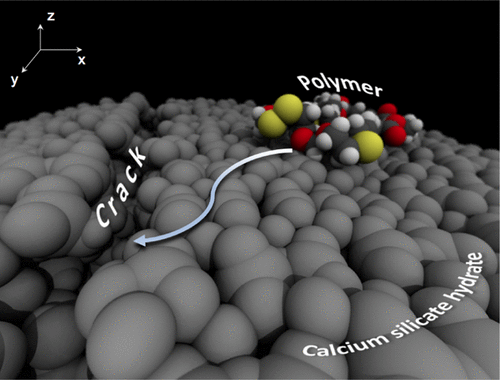当前位置:
X-MOL 学术
›
ACS Appl. Mater. Interfaces
›
论文详情
Our official English website, www.x-mol.net, welcomes your
feedback! (Note: you will need to create a separate account there.)
Atomic Origins of the Self-Healing Function in Cement–Polymer Composites
ACS Applied Materials & Interfaces ( IF 8.3 ) Pub Date : 2018-01-12 00:00:00 , DOI: 10.1021/acsami.7b13309 Manh-Thuong Nguyen 1 , Zheming Wang 1 , Kenton A. Rod 1 , M. Ian Childers 1 , Carlos Fernandez 1 , Phillip K. Koech 1 , Wendy D. Bennett 1 , Roger Rousseau 1 , Vassiliki-Alexandra Glezakou 1
ACS Applied Materials & Interfaces ( IF 8.3 ) Pub Date : 2018-01-12 00:00:00 , DOI: 10.1021/acsami.7b13309 Manh-Thuong Nguyen 1 , Zheming Wang 1 , Kenton A. Rod 1 , M. Ian Childers 1 , Carlos Fernandez 1 , Phillip K. Koech 1 , Wendy D. Bennett 1 , Roger Rousseau 1 , Vassiliki-Alexandra Glezakou 1
Affiliation

|
Motivated by recent advances in self-healing cement and epoxy polymer composites, we present a combined ab initio molecular dynamics and sum frequency generation (SFG) vibrational spectroscopy study of a calcium–silicate–hydrate/polymer interface. On stable, low-defect surfaces, the polymer only weakly adheres through coordination and hydrogen bonding interactions and can be easily mobilized toward defected surfaces. Conversely, on fractured surfaces, the polymer strongly anchors through ionic Ca–O bonds resulting from the deprotonation of polymer hydroxyl groups. In addition, polymer S–S groups are turned away from the cement–polymer interface, allowing for the self-healing function within the polymer. The overall elasticity and healing properties of these composites stem from a flexible hydrogen bonding network that can readily adapt to surface morphology. The theoretical vibrational signals associated with the proposed cement–polymer interfacial chemistry were confirmed experimentally by SFG vibrational spectroscopy.
中文翻译:

水泥-聚合物复合材料自愈功能的原子起源
受自修复水泥和环氧聚合物复合材料最新进展的推动,我们提出了从头算分子动力学和总频率生成(SFG)振动光谱学的组合研究方法,研究了钙-硅酸盐-水合物/聚合物界面。在稳定,低缺陷的表面上,聚合物仅通过配位和氢键相互作用而微弱地粘附,并且很容易向有缺陷的表面移动。相反,在断裂的表面上,聚合物通过聚合物羟基去质子化而通过离子Ca-O键牢固地锚定。此外,聚合物S–S基团远离水泥-聚合物界面,从而实现了聚合物内的自愈功能。这些复合材料的整体弹性和愈合特性来自于可以轻松适应表面形态的柔性氢键网络。SFG振动光谱法通过实验证实了与所提出的水泥-聚合物界面化学有关的理论振动信号。
更新日期:2018-01-12
中文翻译:

水泥-聚合物复合材料自愈功能的原子起源
受自修复水泥和环氧聚合物复合材料最新进展的推动,我们提出了从头算分子动力学和总频率生成(SFG)振动光谱学的组合研究方法,研究了钙-硅酸盐-水合物/聚合物界面。在稳定,低缺陷的表面上,聚合物仅通过配位和氢键相互作用而微弱地粘附,并且很容易向有缺陷的表面移动。相反,在断裂的表面上,聚合物通过聚合物羟基去质子化而通过离子Ca-O键牢固地锚定。此外,聚合物S–S基团远离水泥-聚合物界面,从而实现了聚合物内的自愈功能。这些复合材料的整体弹性和愈合特性来自于可以轻松适应表面形态的柔性氢键网络。SFG振动光谱法通过实验证实了与所提出的水泥-聚合物界面化学有关的理论振动信号。











































 京公网安备 11010802027423号
京公网安备 11010802027423号